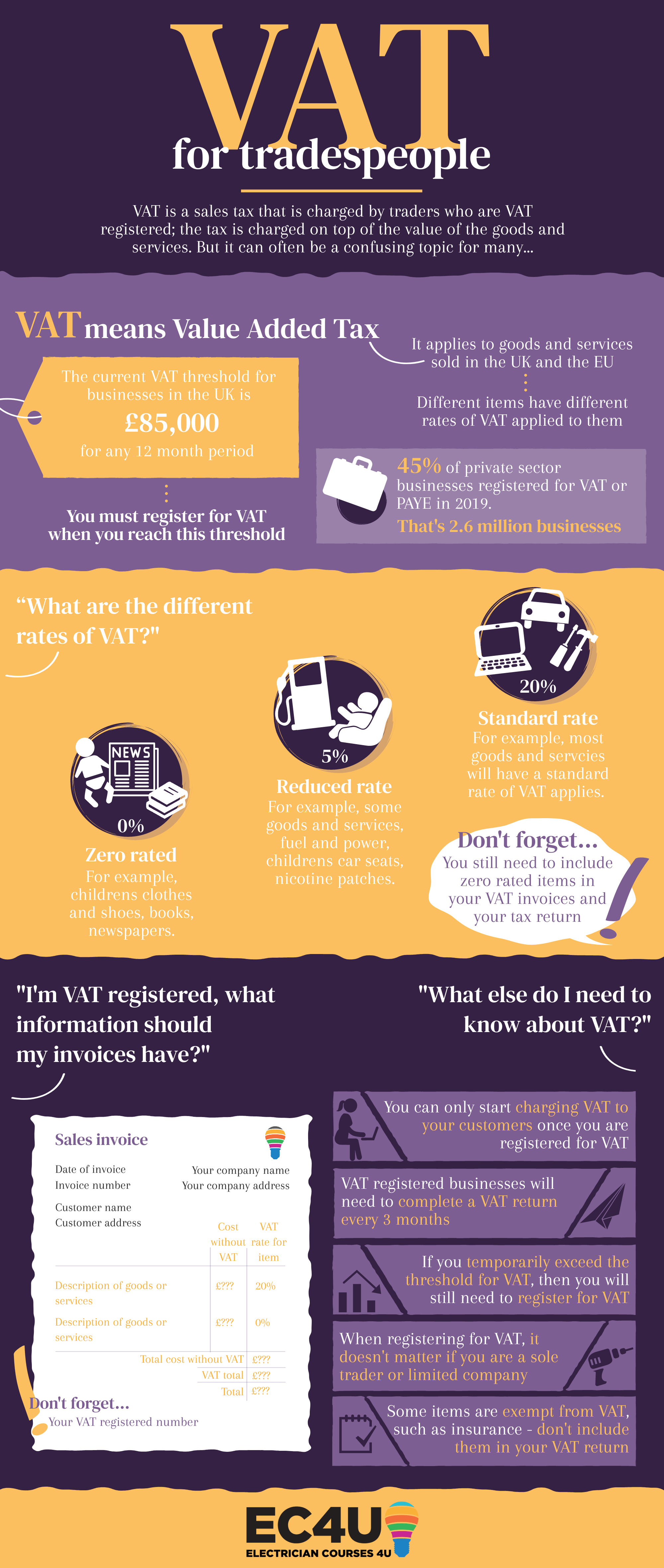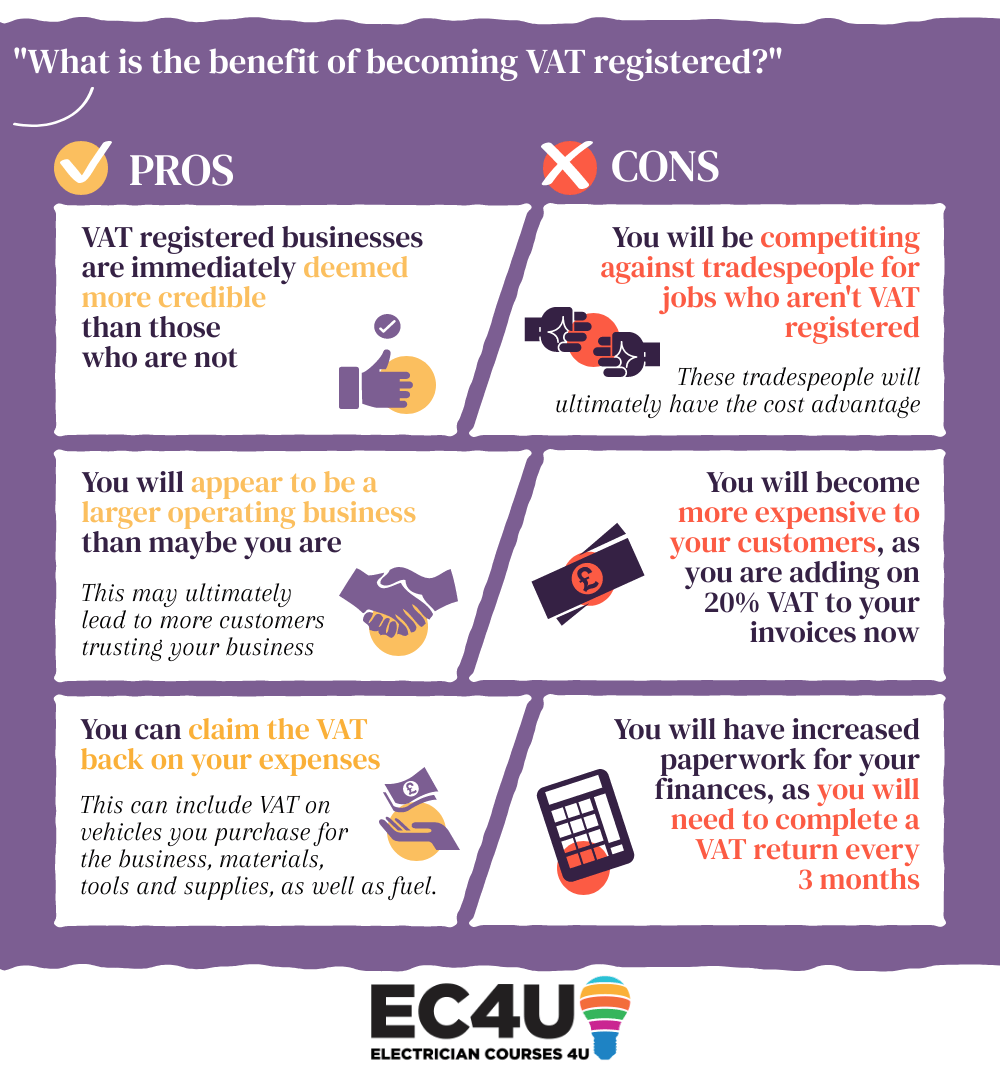Guide to VAT for Tradespeople
We are used to seeing VAT added onto items we buy or expecting it to be there, but what does it mean for a tradesperson? Does every tradesperson have to be VAT registered? What is the VAT threshold? Is it a good thing to be VAT registered?
What is VAT?
VAT stands for Value Added Tax and is a set percentage charge added to certain goods and services in the UK and the EU. For most goods and services, the standard VAT rate is 20%, but this can vary depending on certain items. For the purpose of this guide, we will be looking at VAT from a small business perspective (e.g. tradespeople).
VAT is a sales tax that is charged by traders who are VAT registered; the tax is charged on top of the value of the goods and services. When your annual turnover exceeds the VAT threshold, which is currently £85,000, then you must by law register for VAT. Once you are VAT registered, you must then charge it on goods or services and once the consumer has paid the VAT to you, you will then pay it on to HMRC.

How does VAT work?
VAT can be confusing for many, especially if you are new to the idea of registering for VAT, making VAT returns, the different rates and also claiming VAT back. If you have an accountant, it’s important that you take the time to talk through registering for VAT if and when applicable and what is required. But here is an idea of what is involved, just to get you started…
VAT rates for goods and services
The government place varying rates on different items, which are as follows:
- Standard rate of VAT at 20% – for most goods and services
- Reduced rate of VAT at 5% – for only some goods and services, such as fuel and power, childrens car seats and nicotine patches
- Zero rate of VAT at 0% – for zero rated goods and services, such as childrens clothes, books, newspaper and certain foods.
Unless classed as reduced or zero rated, you can assume that most goods and services will have the standard rate of VAT applied.
For zero rated items, these are still VAT taxable but you must charge your customers the VAT amount of 0%. You will still be required, by law, to record these items in your VAT return.
Some items you may notice are exempt from VAT, including insurance, lottery tickets, funeral costs, and these items you do not have to include in your VAT return.
Taxable VAT Turnover
For many tradespeople, VAT may not yet be in your sights, but it’s important to keep track of your monthly turnover, so that if you do go over the threshold, you are ready to register for VAT.
Your taxable VAT turnover will be the total amount of all goods and services you have sold, that aren’t exempt. The current threshold for VAT in the UK is £85,000 and is fixed for another 2 years from 1st April 2020. If you go over the threshold in a 12 month period, then you are required to register for VAT with HMRC immediately, or if you expect that you will go over the threshold in the coming months, you should also register.
Please note this is not a 12 month financial year, it is any 12 month period, which is why it’s very important to keep an eye on your monthly turnover.
When can I start charging VAT?
You can only start charging VAT to your customers once you are registered for VAT. From this point, you must charge VAT on any goods or services you supply and you may also reclaim any VAT you’ve paid for goods related to the business.
When charging VAT to a customer, the VAT should be visible on the sales invoices that you supply your customer with, as well as the VAT rate applied and you should always have your VAT number on them too.
If you purchase anything business-related, you will usually see VAT added, especially if the supplier is also VAT registered. You cannot claim the VAT back on business related goods if you are not VAT registered.
Making a VAT return to HMRC
VAT registered businesses will need to complete a VAT return every 3 months. This VAT return will record things such as your total sales, any purchases made for the business, the amount of VAT you owe HMRC, the amount of VAT you wish to reclaim from HMRC and the VAT refund amount, if applicable. You are required to submit a VAT return, no matter if you don’t have any VAT to pay or reclaim.
To make things easier for you, you can now complete your VAT return online as part of the government’s move to make tax digital. It is recommended that you keep records of all evidence relating to your VAT returns for at least six years.
VAT return deadline
Don’t forget your VAT return deadlines for submitting online, which are usually 1 calendar month and 7 days after your accounting period. If you miss the deadline for your VAT return, you will automatically enter a surcharge period, which is a 12 month probation period where you risk incurring penalties if late payments persist.
Find out more about making a VAT return, with the government guidance.
Do I need to be VAT registered?
Is your annual turnover under £85,000? No – you do not need to register for VAT, although you can voluntarily register for VAT.
Is your annual turnover £85,000 or more? Yes – you need to register for VAT.
When registering for VAT, it doesn’t matter whether you are a limited company or sole trader, all that qualifies you to apply is your annual turnover in any 12 month period.
Some tradespeople will keep a watchful eye on the annual turnover to ensure they do not cross over the VAT threshold; for example, scheduling large jobs further apart so not in one 12 month period and having the customers buy the materials if they are of a substantial amount, such as a new kitchen, to avoid meeting that threshold unnecessarily.
If you temporarily exceed the threshold for VAT, then you will still need to register for VAT. For example, if you do take on a larger job which you anticipate will push you over the threshold, you will need to inform HMRC within 30 days of the date you become aware of this.
Find out more about VAT for your business, with the government guidance.
Pros and cons of being VAT registered

For tradespeople, the key difference in not being registered for VAT and being a VAT registered business, is that when you register, you become more expensive to your customers. This is because you are adding on 20% VAT to every invoice you produce and ultimately have to charge your customers.
This can be both a pro and a con, as becoming VAT registered comes with competition. You will be competing against tradespeople for jobs who may not be VAT registered and in turn, will not have to add 20% onto their labour costs and invoices for their customers. This ultimately makes you appear more expensive to the customer and have a higher chance of pricing you out of the job.
However, a positive is that VAT registered businesses are immediately deemed more credible and trustworthy than those who are not. This may be because the business has a duty to carry out VAT returns, can claim expenses back or are seen to be turning over a certain amount of money (or more) per year.
Another downside to be VAT registered for many is the influx of paperwork you will now have to complete in order to keep up to date with your quarterly VAT returns. It’s important that you keep your records organised, as if you get your VAT return wrong or miss the deadline, you will face penalties.
Some of the benefits to being VAT registered can also include claiming your expenses back, such as VAT on a van you buy for your business, tools, materials and supplies for jobs, and fuel on your journeys. These benefits ultimately make it cheaper in the long run as you are able to claim this VAT back, where those who aren’t registered would pay the full price, getting nothing back in return.




